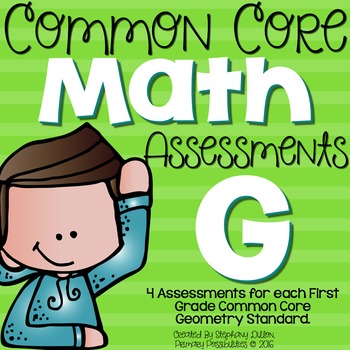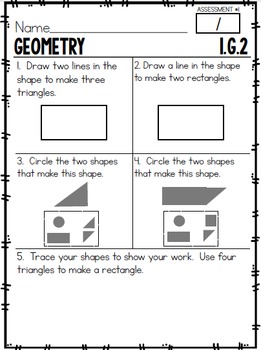First Grade Common Core Math Assessments- Geometry 1.G.1, 1.G.2, 1.G.3
Stephany Dillon
11.9k Followers
Grade Levels
K - 2nd
Subjects
Resource Type
Standards
CCSS1.G.A.1
CCSS1.G.A.2
CCSS1.G.A.3
Formats Included
- PDF
Pages
28 pages
Stephany Dillon
11.9k Followers
Description
4 Assessments for each First Grade Common Core GEOMETRY Standards 1.G.1, 1.G.2, 1.G.3
These assessments cover shapes, making new shapes, partitioning shapes and fractions.
Be prepared to assess and graph student growth on the Common Core Standards!
Each test contains a total of 5 questions. The assessments within the standard have the same format to ensure consistency in data. Students show proficiency when they score a 4/5 or 5/5.
Included in this packet:
Cover Sheet with Standard for Binding
1 Pretest for Each Standard
3 Assessments for Each Standard
Scoring Sheet
Class Graphing Sheet
Student Graphing Sheets
Created by Stephany Dillon
stephany.dillon@gmail.com
These assessments cover shapes, making new shapes, partitioning shapes and fractions.
Be prepared to assess and graph student growth on the Common Core Standards!
Each test contains a total of 5 questions. The assessments within the standard have the same format to ensure consistency in data. Students show proficiency when they score a 4/5 or 5/5.
Included in this packet:
Cover Sheet with Standard for Binding
1 Pretest for Each Standard
3 Assessments for Each Standard
Scoring Sheet
Class Graphing Sheet
Student Graphing Sheets
Created by Stephany Dillon
stephany.dillon@gmail.com
Total Pages
28 pages
Answer Key
N/A
Teaching Duration
N/A
Report this resource to TPT
Reported resources will be reviewed by our team. Report this resource to let us know if this resource violates TPT’s content guidelines.
Standards
to see state-specific standards (only available in the US).
CCSS1.G.A.1
Distinguish between defining attributes (e.g., triangles are closed and three-sided) versus non-defining attributes (e.g., color, orientation, overall size); build and draw shapes to possess defining attributes.
CCSS1.G.A.2
Compose two-dimensional shapes (rectangles, squares, trapezoids, triangles, half-circles, and quarter-circles) or three-dimensional shapes (cubes, right rectangular prisms, right circular cones, and right circular cylinders) to create a composite shape, and compose new shapes from the composite shape.
CCSS1.G.A.3
Partition circles and rectangles into two and four equal shares, describe the shares using the words halves, fourths, and quarters, and use the phrases half of, fourth of, and quarter of. Describe the whole as two of, or four of the shares. Understand for these examples that decomposing into more equal shares creates smaller shares.





